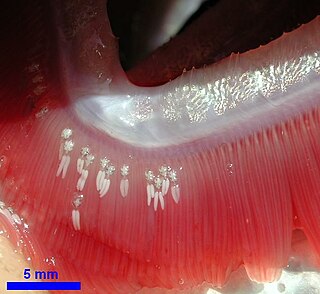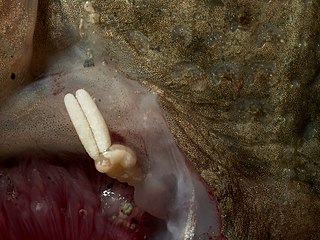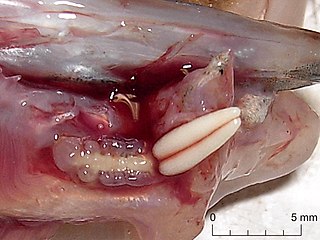
Copepods are a group of small crustaceans found in nearly every freshwater and saltwater habitat. Some species are planktonic, some are benthic, a number of species have parasitic phases, and some continental species may live in limnoterrestrial habitats and other wet terrestrial places, such as swamps, under leaf fall in wet forests, bogs, springs, ephemeral ponds, puddles, damp moss, or water-filled recesses of plants (phytotelmata) such as bromeliads and pitcher plants. Many live underground in marine and freshwater caves, sinkholes, or stream beds. Copepods are sometimes used as biodiversity indicators.

Calanus is a genus of marine copepod in the family Calanidae. The genus was split in 1974, with some species being placed in a new genus, Neocalanus. The following species are recognised:

Ergasilidae is a widespread family of copepods and comprises many species. The type genus is Ergasilus. With a few doubtful exceptions all ergasilids are parasitic on fishes.

Ergasilus is a genus of copepod crustaceans occurring in both the ocean and fresh water, often called gill lice. The females are parasitic upon the gills of fishes. Being copepods, gill lice have a single median eye on their head. The second antennae are modified into prehensile pincers. Male gill lice are free-living.

Chondracanthidae is a family of parasitic copepods, usually found infecting the branchial chamber of demersal fishes. It comprises the following genera:
Centropagidae is a family of copepods in the order Calanoida. Its members are particularly known as plankton in coastal waters and in fresh water in Australia and southern South America. They are also found on subantarctic islands and in lakes in Antarctica.

Lernaeocera is a genus of marine copepods in the family Pennellidae.

Caligus is a genus of sea lice in the family Caligidae. The species are parasites of marine fishes and could be vectors of viruses. As of 2017, the World Register of Marine Species includes the following species:

Pontella is a marine copepod genus in the family Pontellidae. It is an organism that bears three lenses in the eye. The outer has a parabolic surface, countering the effects of spherical aberration while allowing a sharp image to be formed.

Lernaeopodidae is a family of parasitic copepods. The females are typically large and fleshy, and attach to the host permanently using a plug made of chitin called the bulla. The males cling on to the females using their antennae. They parasitize both marine and freshwater fish. Some lernaeopodids, including Clavella and Salmincola, can have negative impacts on fish in aquaculture.
Chondracanthus is a parasitic copepod genus in the family Chondracanthidae, containing the following species:

Acanthochondria is a genus of copepods, containing the following species:

Lepeophtheirus is a genus of sea louse. The best-known species is L. salmonis, the salmon louse. Other species include L. pectoralis, which uses flatfish as its host, particularly the European flounder, and is also the type species of the genus Lepeophtheirus.

Lepeophtheirus pectoralis is a species of parasitic copepod from the northeast Atlantic Ocean, and the type species of the genus Lepeophtheirus. It is a parasite of flatfish, with the European flounder, the plaice, and the dab as the most frequent hosts. It feeds on the mucus, skin, and blood of the fish, with egg-producing females infecting the pectoral and pelvic fins of the host, while immature individuals and males are found on the rest of the body.
Peniculisa is a genus of marine parasitic copepods in the family Pennellidae.
Centropages is a genus of copepods in the family Centropagidae with 34 known marine species.
Neocalanus is a genus of marine copepods. They are a dominant component of the open water ecosystems of the northern Pacific Ocean. Neocalanus are large copepods, reaching body lengths of more than 8 mm (0.31 in) in Neocalanus plumchrus.

The clade Multicrustacea constitutes the largest superclass of crustaceans, containing approximately four-fifths of all described crustacean species, including crabs, lobsters, crayfish, shrimp, krill, prawns, woodlice, barnacles, copepods, amphipods, mantis shrimp and others. The largest branch of multicrustacea is the class Malacostraca.

Peniculus is a genus of marine copepods in the family Pennellidae. They occur worldwide and typically parasitize coastal or epipelagic fish, with the exception of Peniculus hokutoae that was found parasitizing a mesopelagic myctophid, Symbolophorus evermanni.

Acanthochondria cornuta is a species of parasitic copepod from the northeast Atlantic Ocean, and the type species of the genus Acanthochondria. It infects the gills of several species of flatfish, particularly the European flounder. Copepodids and immature females infect the holobranch of the host, while adult females prefer the pseudobranch and the internal wall, suggesting they migrate upstream in the gills of the host as they mature.













